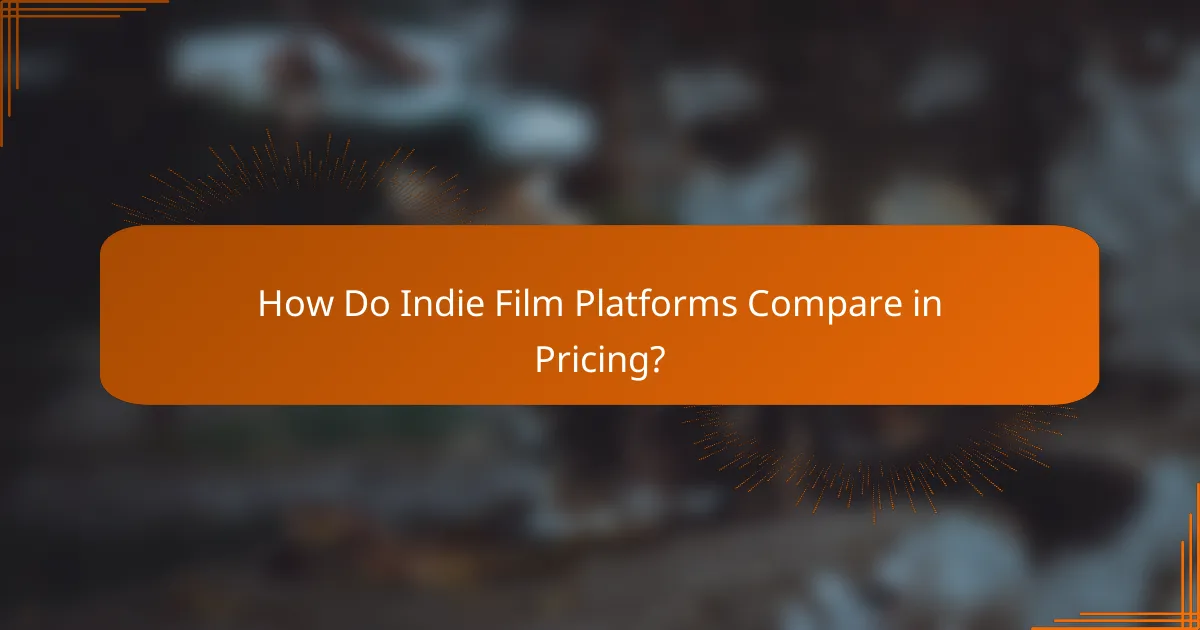Indie film platforms have emerged as vital spaces for diverse content, appealing to a wide range of tastes and preferences. Notable platforms like Amazon Prime Video, Vimeo On Demand, and IndieFlix offer unique features and extensive film selections, enhancing user satisfaction through tailored experiences and flexible subscription options.

Which Indie Film Platforms Offer the Most Content Variety?
Several indie film platforms stand out for their diverse content offerings, catering to various tastes and preferences. Key players include Amazon Prime Video, Vimeo On Demand, FilmFreeway, IndieFlix, and Kanopy, each providing unique features and a range of films.
Amazon Prime Video
Amazon Prime Video hosts a significant selection of indie films, often featuring both popular titles and lesser-known gems. Users can access thousands of films, with options for rental or purchase, making it a versatile choice for indie film enthusiasts.
Consider subscribing to Amazon Prime for additional benefits, such as free shipping and access to other streaming content. However, be aware that the indie film selection may vary by region, so check local availability.
Vimeo On Demand
Vimeo On Demand focuses on independent filmmakers, allowing them to sell their work directly to viewers. This platform features a curated selection of films, often highlighting unique storytelling and artistic expression.
Filmmakers set their own prices, which can range from a few dollars to higher amounts for exclusive content. Users can support indie creators while enjoying a diverse array of films that may not be available elsewhere.
FilmFreeway
FilmFreeway primarily serves as a submission platform for film festivals, but it also showcases a variety of indie films. Users can discover new works that have been featured in festivals around the world, providing a unique viewing experience.
While FilmFreeway is not a traditional streaming service, it offers a way to access films that may have limited distribution. Check for festival screenings or online events to enjoy these indie films.
IndieFlix
IndieFlix specializes in independent films, documentaries, and shorts, offering a subscription model for viewers. The platform emphasizes quality content, with a focus on storytelling that resonates with diverse audiences.
IndieFlix also supports filmmakers by providing a share of subscription revenue. This model encourages the creation of more indie content, making it a great choice for viewers who want to support the indie film community.
Kanopy
Kanopy partners with libraries and educational institutions to provide free access to a wide range of indie films. Users can stream films at no cost with a library card, making it an accessible option for many.
The platform features a curated selection of films, including classics and contemporary works, often with a focus on social issues and cultural diversity. Check your local library for access and enjoy a rich variety of indie films without any fees.

How Do User Ratings Reflect Satisfaction on Indie Film Platforms?
User ratings are a crucial indicator of satisfaction on indie film platforms, providing insights into audience preferences and film quality. These ratings often reflect the collective opinion of viewers, helping potential watchers gauge whether a film aligns with their tastes.
Rotten Tomatoes Scores
Rotten Tomatoes uses a unique scoring system that aggregates critic and audience ratings to produce a percentage score. A film with a high score, typically above 70%, is generally considered well-received, while scores below 50% indicate mixed or negative reviews. This dual rating system allows users to see both professional and public opinions side by side.
For indie films, a strong Rotten Tomatoes score can significantly boost visibility and attract more viewers. However, it’s essential to consider the number of reviews contributing to the score; a film with a few high ratings may not be as reliable as one with a larger pool of reviews.
User Reviews on IMDb
IMDb allows users to rate films on a scale from 1 to 10, with the average rating displayed prominently. This straightforward approach provides a quick snapshot of a film’s reception among viewers. A rating of 7 or above is often seen as favorable, while scores below 5 may deter potential viewers.
In addition to numerical ratings, user reviews on IMDb offer detailed feedback, highlighting specific strengths and weaknesses of indie films. When reading reviews, look for patterns in comments to better understand the film’s appeal or shortcomings.
Audience Feedback on Letterboxd
Letterboxd is a social platform where users can rate, review, and discuss films, creating a community-driven atmosphere. Ratings are presented alongside personal reviews, allowing for deeper engagement with the content. A film with a high average rating and numerous reviews can indicate strong audience satisfaction.
Letterboxd also features lists and watchlists, which can help users discover indie films that resonate with their interests. Engaging with the community through comments and discussions can provide additional context and enhance the viewing experience.

What Are the Key Features of Popular Indie Film Platforms?
Popular indie film platforms typically focus on providing diverse content, flexible subscription options, and user-friendly interfaces. These features enhance user satisfaction by catering to the specific needs of indie film enthusiasts.
Subscription Models
Indie film platforms often offer various subscription models, including monthly, annual, and pay-per-view options. Monthly subscriptions generally range from $5 to $15, while annual plans can provide discounts, making them more economical for frequent viewers.
Pay-per-view models allow users to rent or purchase specific films, which can be beneficial for those who prefer not to commit to a subscription. Consider your viewing habits when choosing a model to ensure you get the best value for your investment.
Content Curation
Content curation on indie film platforms is crucial for discovering quality films. Many platforms employ expert curators who select films based on themes, genres, or critical acclaim, helping users navigate the vast library.
Some platforms also feature user-generated lists and recommendations, enhancing the discovery process. Look for platforms that regularly update their content to keep the selection fresh and engaging.
User Interface Design
A clean and intuitive user interface is essential for a satisfying viewing experience. Popular indie film platforms prioritize easy navigation, allowing users to search for films by genre, director, or release date without hassle.
Responsive design is another key aspect, ensuring that the platform works seamlessly across devices, from smartphones to smart TVs. When choosing a platform, consider how well it adapts to your preferred viewing method for optimal enjoyment.

How Do Indie Film Platforms Compare in Pricing?
Indie film platforms vary significantly in pricing models, catering to different viewer preferences and budgets. Understanding these differences can help users choose the best option for accessing independent films.
Monthly Subscription Costs
Many indie film platforms offer monthly subscription plans, typically ranging from $5 to $15 per month. These subscriptions often provide unlimited access to a library of films, making them a cost-effective choice for avid viewers.
Platforms like MUBI and Criterion Channel are known for their curated selections, which may justify higher price points. Consider how often you watch films to determine if a subscription is worth the investment.
Pay-Per-View Options
Pay-per-view options allow users to rent or purchase individual films, usually costing between $2 and $10 per title. This model is ideal for those who prefer not to commit to a subscription or want to watch specific films without ongoing costs.
Platforms such as Vudu and Amazon Prime Video often feature indie films available for rent or purchase. Be mindful of rental periods, as they typically range from 24 to 48 hours after starting the film.
Free Trials and Promotions
Many indie film platforms offer free trials or promotional discounts for new users, allowing them to explore the content without immediate financial commitment. These trials can last from a week to a month, depending on the platform.
Take advantage of these offers to assess the film selection and user experience. Just remember to cancel before the trial ends if you decide not to continue, to avoid being charged. Keep an eye out for seasonal promotions that may provide extended access or discounted rates.

What Are the User Demographics for Indie Film Platforms?
User demographics for indie film platforms typically include a diverse audience, often skewing towards younger viewers who are tech-savvy and interested in unique storytelling. This demographic is crucial for indie filmmakers aiming to reach audiences that appreciate independent cinema.
Age Groups
The primary age group for indie film platforms tends to be between 18 and 34 years old. This demographic is drawn to innovative narratives and often seeks out films that challenge mainstream conventions. However, there is also a growing interest among older viewers, particularly those aged 35 to 54, who appreciate the artistic value and cultural significance of indie films.
Understanding these age groups can help filmmakers tailor their marketing strategies and content offerings to better engage their target audience.
Geographic Distribution
Indie film platforms attract users from various geographic locations, with significant concentrations in urban areas where access to independent cinema is more prevalent. In the United States and Europe, cities like New York, Los Angeles, London, and Berlin are hotspots for indie film enthusiasts.
Additionally, platforms are increasingly reaching international audiences, particularly in regions like Southeast Asia and Latin America, where interest in diverse film narratives is on the rise.
Viewing Habits
Users of indie film platforms often prefer on-demand viewing, allowing them to watch films at their convenience. Many viewers engage with content during evenings and weekends, reflecting a preference for leisure time consumption.
Furthermore, binge-watching is common, with audiences likely to watch multiple films in one sitting, especially during film festivals or themed showcases. Filmmakers should consider these habits when planning release schedules and promotional strategies.

What Criteria Should You Consider When Choosing an Indie Film Platform?
When selecting an indie film platform, consider factors such as content variety, user interface, audience reach, and revenue models. These criteria will help ensure that your film reaches the right audience and generates the desired engagement.
Content Variety
Content variety refers to the range of genres and styles available on the platform. A platform with a diverse selection can attract a broader audience, increasing the chances of your film being discovered. Look for platforms that showcase different types of indie films, including documentaries, shorts, and experimental works.
Additionally, consider whether the platform supports international films or niche genres. Platforms that cater to specific audiences or cultural themes can provide unique opportunities for exposure. For instance, some platforms may focus on [censured] films, while others might highlight regional cinema.
User Satisfaction
User satisfaction is crucial for the success of an indie film platform. High ratings and positive reviews can indicate a platform’s reliability and effectiveness in promoting films. Check user feedback on aspects such as ease of navigation, streaming quality, and customer support.
Engagement metrics, such as average watch time and user retention rates, can also provide insights into how well a platform retains its audience. Platforms that offer interactive features, like community discussions or filmmaker Q&As, may enhance user satisfaction and foster a loyal viewer base.
Revenue Models
Understanding the revenue models of indie film platforms is essential for filmmakers. Common models include subscription-based services, pay-per-view, and ad-supported streaming. Each model has its pros and cons, so consider which aligns best with your financial goals.
For example, subscription platforms may provide a steady income stream but require a larger audience to be profitable. In contrast, pay-per-view models can yield higher returns per view but may result in lower overall exposure. Evaluate your film’s potential audience and choose a platform that offers a revenue model that suits your needs.


